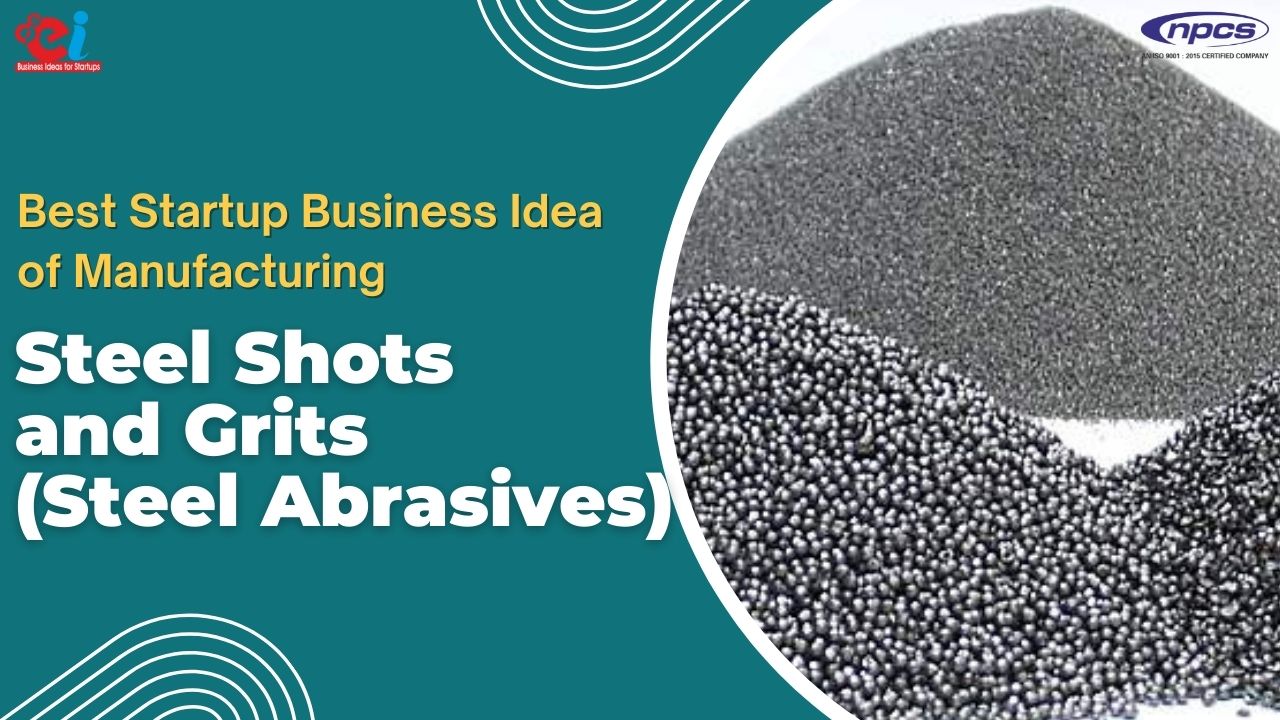Manufacturing steel shots and grits is a booming industrial business idea with growing demand in surface preparation, automotive, foundries, and metal treatment sectors. Steel shots and grits are essential abrasives used in processes such as shot blasting, shot peening, cleaning, and surface finishing of metal parts. With infrastructure development and heavy industry growth across the globe, the consumption of steel abrasives has seen a consistent rise.
Starting a steel shots and grits manufacturing business can be highly profitable if backed by modern machinery, quality control, and access to heavy industries. Entrepreneurs exploring high-demand industrial manufacturing should consider this venture for its scalability and export potential.
Business Plan: Steel Shots & Grits (Steel Abrasives) Manufacturing Business
What Are Steel Shots and Grits?
Steel shots are spherical-shaped steel abrasives, while steel grits are angular-shaped particles formed by crushing steel shots. Both are used for:
-
Cleaning metal surfaces by removing rust, scale, and paint
-
Surface preparation before coating or painting
-
Peening to increase fatigue strength of components
-
Cutting of stone (steel grits especially)
Steel shots provide a smooth finish, while steel grits give a rougher texture and are used for aggressive cleaning.
Visit this Page for More Information: Start a Business in Steel Industry
1. Applications of Steel Shots and Grits
Steel shots and grits are indispensable in several industries, including:
-
Automotive and aerospace (shot peening)
-
Foundries and casting units
-
Construction and shipbuilding
-
Steel fabrication workshops
-
Granite and marble cutting
-
Pipe and tube manufacturing
-
Surface treatment and blasting equipment companies
Their durability and reusability make them cost-effective compared to sand or mineral abrasives.
Read our Books Here: Steel, Iron, Ferrous, Non-Ferrous Metals with Casting and Forging, Aluminium, Ferroalloys Technology
2. Manufacturing Process of Steel Shots and Grits
The steel shots and grits manufacturing process involves several steps to ensure quality, shape, hardness, and durability:
a. Raw Material
-
High-carbon steel scrap or wire rods (0.8% – 1.2% carbon)
-
Ferro alloys for alloying
-
Water or oil (for quenching)
-
Screening and grading materials
b. Manufacturing Steps:
-
Melting: Steel scrap is melted in an electric induction furnace.
-
Atomization:
-
The molten steel is poured into a stream of water (water jet atomization) or mechanically broken into droplets.
-
The droplets cool rapidly and solidify into spherical particles (steel shots).
-
-
Crushing (for steel grits):
-
Steel shots are crushed to obtain angular-shaped steel grits.
-
-
Heat Treatment:
-
Particles are quenched and tempered to achieve the desired hardness and microstructure.
-
-
Screening and Grading:
-
The shots and grits are passed through vibrating sieves to segregate into different sizes and grades (S230, S330, G25, G50, etc.).
-
-
Quality Testing and Packaging:
-
Final products are checked for shape, hardness, and density.
-
Packed in HDPE bags or drums (25kg, 50kg, or bulk bags).
-
3. Required Machinery and Equipment
A steel shots and grits manufacturing business requires:
-
Induction furnace (500–1000 kg capacity)
-
Atomizing unit (water jet or mechanical)
-
Crushing unit (for grits)
-
Heat treatment furnace (quenching tank, tempering system)
-
Vibratory sieve shakers and screens
-
Dust collectors and pollution control system
-
Conveyor and bucket elevators
-
Packaging unit (manual/semi-auto)
Plant Area Needed: 15,000–25,000 sq. ft.
Manpower: 15–25 (engineers, operators, QC, helpers)
Related Feasibility Study Reports: Steel and Steel Products
4. Licensing and Registration
To legally operate a steel shots and grits manufacturing unit, you will need:
-
Company registration (Pvt Ltd / LLP / MSME)
-
Factory license
-
Pollution Control Board (PCB) NOC
-
GST registration
-
Udyam registration
-
Fire safety certificate
-
BIS Certification (for quality assurance and tenders)
Additional certifications like ISO 9001 or ISO 11124 can help with international market access.
Read Similar Articles: Iron and Steel Projects
5. Market Scope and Buyers
India is a major steel producer, and the abrasive industry is aligned with sectors like auto, construction, foundries, and railways.
Domestic Buyers:
-
Shot blasting machine manufacturers
-
Foundries and fabricators
-
Construction and shipyard companies
-
Pipe and tube manufacturers
-
Railways and defense contractors
Export Opportunities:
-
Middle East (UAE, Saudi Arabia)
-
Africa (Nigeria, Egypt)
-
Southeast Asia (Vietnam, Thailand)
-
Europe and Latin America
You can export via EPC registration and D&B ratings to global buyers.
6. Cost of Setting Up the Business
Here’s a basic cost structure to start a medium-scale steel shots and grits manufacturing plant:
Small-Scale Unit (1–2 TPD):
-
Machinery: ?35–45 lakhs
-
Land/Building: ?20 lakhs (owned or rented)
-
Utilities & setup: ?10 lakhs
-
Licenses: ?5 lakhs
-
Working Capital (3–6 months): ?15–20 lakhs
Total Investment: ?75 lakhs – ?1 crore
Medium-Scale Unit (5–10 TPD):
-
Machinery: ?80–100 lakhs
-
Infrastructure: ?30–40 lakhs
-
Utilities & installation: ?15–20 lakhs
-
Working Capital: ?50 lakhs
Total Investment: ?1.8 – ?2.2 crore
7. Profitability and ROI
Manufacturing steel shots and grits has a consistent demand and offers healthy profit margins, especially in B2B sales.
-
Production cost per ton: ?25,000 – ?30,000
-
Selling price per ton: ?40,000 – ?55,000 (grade-dependent)
-
Net margin: 20–30% per ton
-
Break-even: 2–3 years (faster with steady industrial contracts)
You can increase margins by supplying directly to OEMs, offering custom blends, and targeting export markets.
8. Marketing and Sales Strategy
To succeed in this business, focus on:
-
B2B lead generation on platforms like IndiaMART, Alibaba, TradeIndia
-
Product certification for government tenders
-
Attending trade shows like IMTEX, India Surface Finishing Expo
-
Collaborating with blasting machine OEMs
-
Developing a professional website with specifications, grades, and test reports
-
Targeting large EPC contractors for infrastructure projects
Good after-sales support and consistent quality will help build long-term contracts.
Final Thoughts
The steel shots and grits manufacturing business is a highly scalable, B2B industrial venture with strong domestic and international demand. With the continuous expansion of infrastructure, railways, shipbuilding, and steel fabrication industries, this product remains vital for surface cleaning and finishing.
By focusing on quality, regulatory compliance, and export-grade production, entrepreneurs can capture a significant share in the abrasives market. With the right strategy and production setup, this business offers long-term profitability and growth.
Download PDF: Manufacturing of Steel Shots and Grits
Some Useful Links:
- Start a Business in Asia
- Start a Business in Potential Countries for Doing Business
- Best Industry for Doing Business
- Business Ideas with Low, Medium & High Investment
- Looking for Most Demandable Business Ideas for Startups
- Startup Consulting Services
- Start a Business in Africa
- Start a Business in India
- Start a Business in Middle East
- Related Videos
- Related Books
- Related Projects
- Related Market Research Reports
NIIR PROJECT CONSULTANCY SERVICES, DELHI
An ISO 9001:2015 Company
ENTREPRENEUR INDIA
106-E, Kamla Nagar, Opp. Mall ST,
New Delhi-110007, India.
Email: npcs.ei@gmail.com
Tel: +91-11-23843955, 23845654, 23845886
Mobile: +91-9097075054, 8800733955
Website: https://www.entrepreneurindia.co
https://www.niir.org






